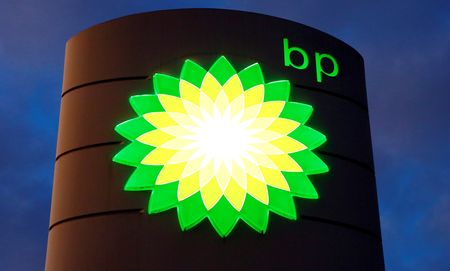
By Ron Bousso and Shadia Nasralla
LONDON (Reuters) -BP on Tuesday reported a record profit of $28 billion for 2022 while boosting its dividend in a sign of confidence as it sharply raised overall spending plans and scaled back ambitions to reduce oil and gas output by 2030.
The blockbuster profit follows similar reports from rivals Shell, Exxon Mobil and Chevron last week after energy prices surged in the wake of Russia’s invasion of Ukraine, prompting new calls to further tax the sector as households struggle to pay energy bills.
Three years after Chief Executive Bernard Looney took the helm with an ambitious plan to pivot BP away from oil and gas towards renewables and low-carbon energy, the company said it will increase annual spending in both sectors by $1 billion with a sharper focus on developing low-carbon biofuels and hydrogen.
But it scaled back plans to cut oil output, now aiming to produce 2 million barrels of oil equivalent per day by 2030, down just 25% from 2019 levels compared with previous plans for a 40% cut. Looney said that would not impact a target of reducing emissions from fuels BP sells by up to 40% by the end of the decade.
While many investors backed Looney’s strategy, which he told Reuters “is working”, BP’s shares have significantly underperformed top Western energy companies since the CEO took office, remaining largely flat compared with a 17% gain for Shell and a nearly 80% rise in Exxon shares.
“In a departure from its peers, it would appear that criticisms of its spending on renewables has started to sting,” said Michael Hewson, Chief Market Analyst at CMC Markets UK.
BP’s $4.8 billion fourth-quarter underlying replacement cost profit, its definition of net income, narrowly missed a $5 billion company-provided analyst forecast and compared with $4 billion a year earlier and $8.2 billion in the third quarter.
The results were impacted by weaker gas trading activity after an “exceptional” third quarter, higher refinery maintenance and lower oil and gas prices.
But for the year, BP’s $27.6 billion profit exceeded its 2008 record of $26 billion despite a $25 billion writedown of its Russian assets.
That allowed it to boost its dividend by 10% to 6.61 cents per share, after halving it in the wake of the pandemic, and announce plans to repurchase $2.75 billion worth of shares over the next three months after buying $11.7 billion in 2022.
BP shares rose 5.6% by 1220 GMT to their highest since early 2020.
ENERGY TRANSITION
BP reiterated plans to divide its spending to 2030 equally between the oil and gas business and its energy transition businesses, upping the total budget to up to $18 billion from a previously guided upper range of $16 billion.
Transition businesses, such as renewables and electric vehicle charging, account for around 30% of the current budget compared with 3% in 2019.
BP kept it returns outlook for renewables largely unchanged at 6%-8%, without taking into account debt, even though global offshore wind production costs have soared in recent months.
Looney said BP’s wind and solar production will focus more on providing renewable power to generate biofuels and low-carbon hydrogen, doubling down, particularly in the United States where the landmark Inflation Reduction Act offers investment credits and tax cuts.
BP, whose trading operations further boost renewables returns, maintained plans to have 50 gigawatts of renewable projects under development and 10 GW operating by 2030.
It said it expects returns of upwards of 15% from its bioenergy business and its combined electric vehicle charging and convenience store businesses, while looking for double-digit returns on hydrogen.
It aims to translate this into a core profit from the transition businesses of $10 billion-$12 billion by 2030, out of targeted total group earnings before interest, tax, depreciation and amortisation (EBITDA) of $51 billion-$56 billion.
BP also wants to increase its focus on renewable natural gas having last year acquired U.S. producer Archaea Energy for $4.1 billion, and it has also set a target to produce 0.5 million-0.7 million tonnes a year of low-carbon hydrogen to initially supply its own refineries.
BP, which increased its 2030 oil price forecast by $10 to $70 a barrel, will focus its global oil and gas operations in nine regions, with plans to sharply increase output from its U.S. shale business and in the Gulf of Mexico.
(Reporting by Ron Bousso and Shadia Nasralla; Editing by Andrew Heavens, Louise Heavens, Kirsten Donovan)

